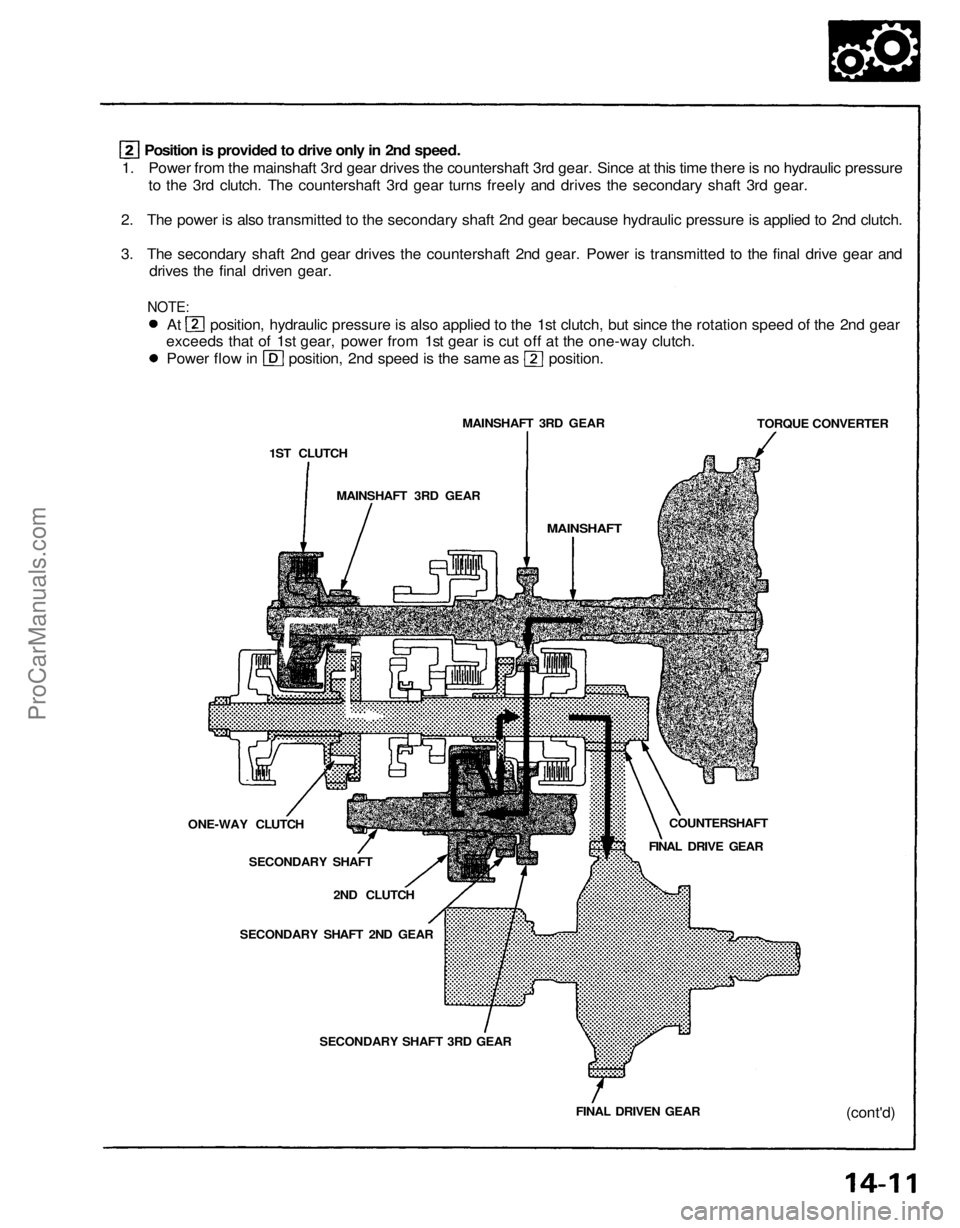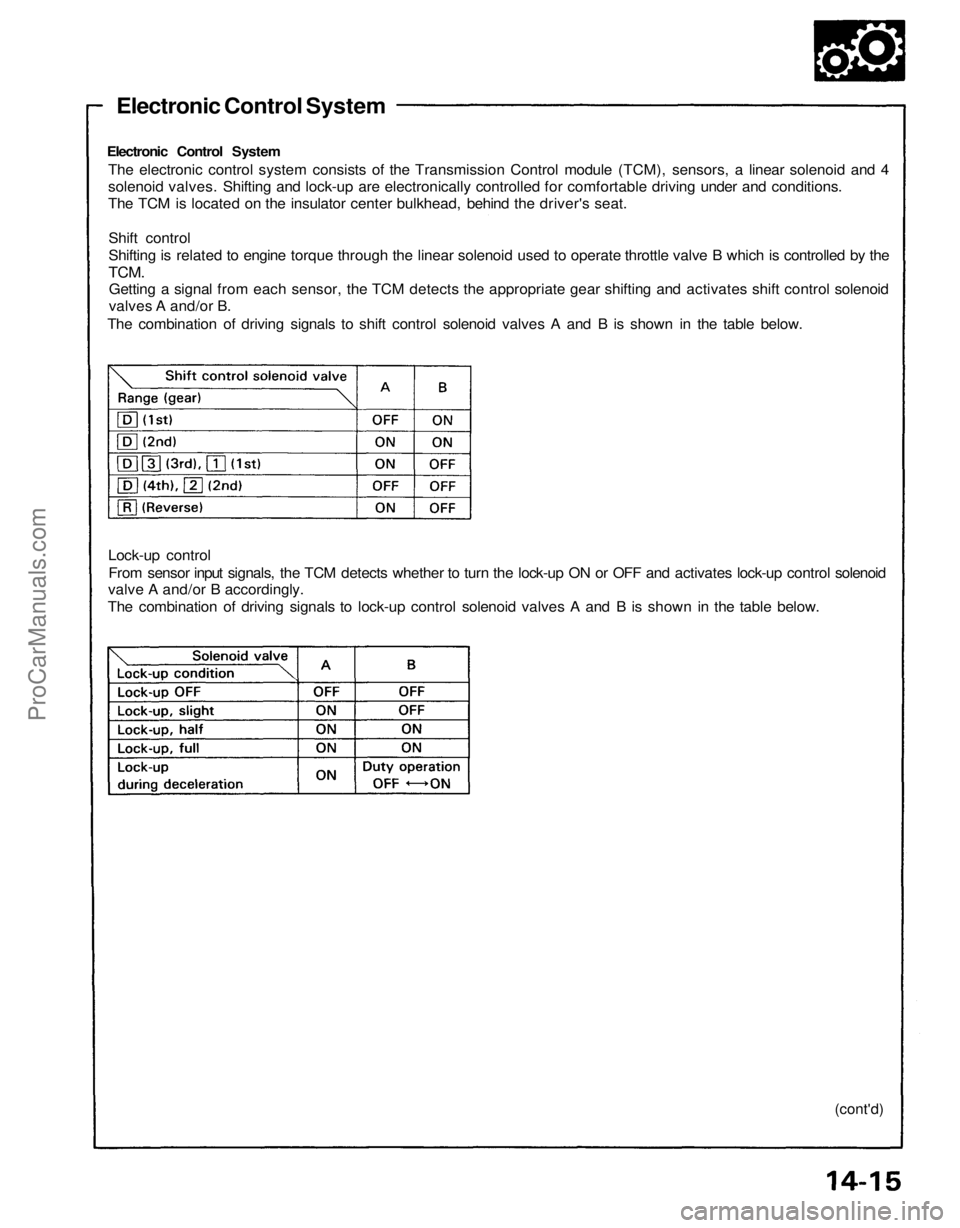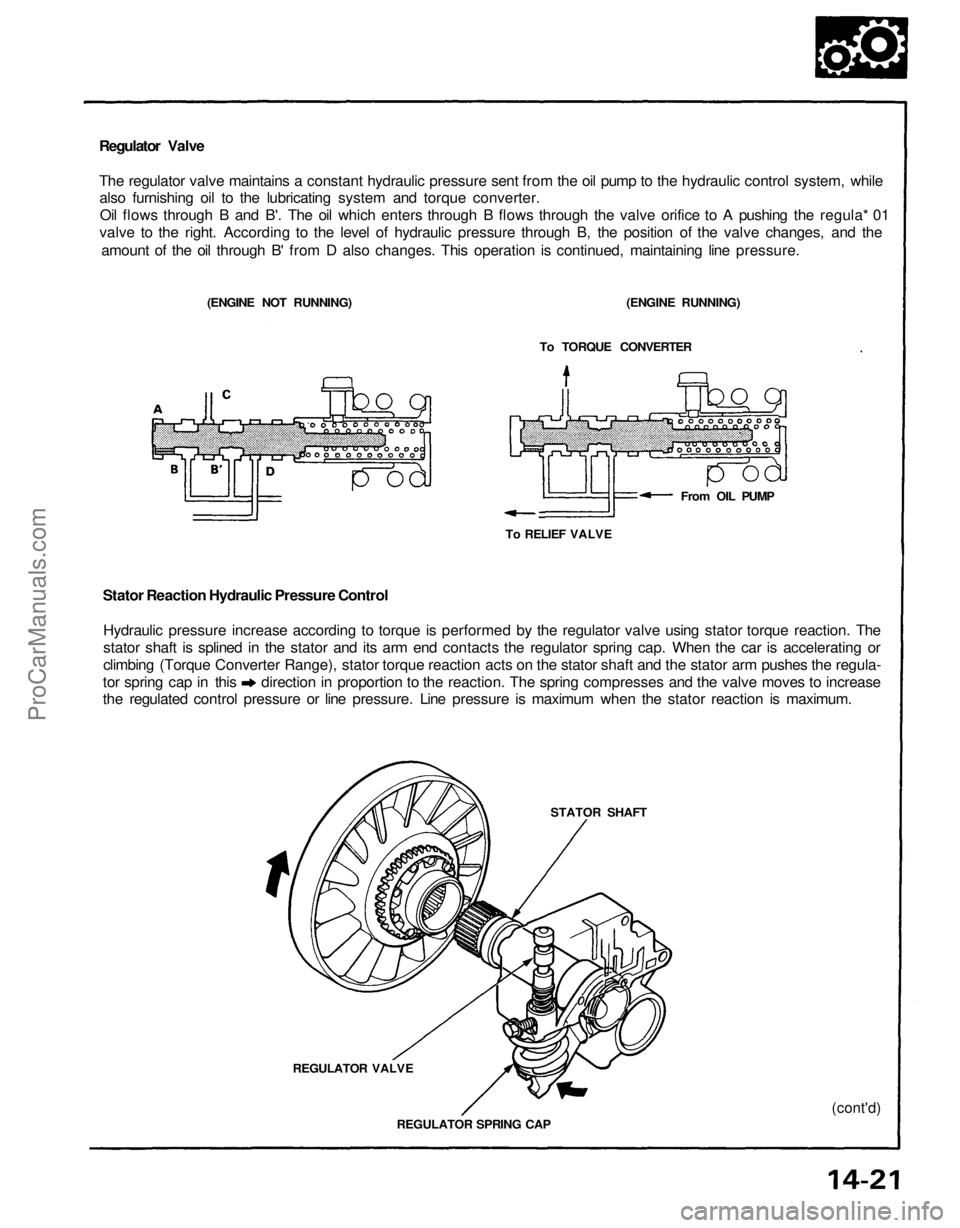Page 1173 of 1640

1. Power from the mainshaft 3rd gear drives the countershaft 3rd gear. Since at this time there is no hydraulic pressure
to the 3rd clutch. The countershaft 3rd gear turns freely and drives the secondary shaft 3rd gear.
2. The power is also transmitted to the secondary shaft 2nd gear because hydraulic pressure is applied to 2nd clutch.
3. The secondary shaft 2nd gear drives the countershaft 2nd gear. Power is transmitted to the final drive gear and
drives the final driven gear.
1ST CLUTCH
MAINSHAFT 3RD GEAR
MAINSHAFT 3RD GEAR
MAINSHAFT
COUNTERSHAFT
FINAL DRIVE GEAR
(cont'd)
FINAL DRIVEN GEAR
SECONDARY SHAFT 3RD GEAR
SECONDARY SHAFT 2ND GEAR
2ND CLUTCH
SECONDARY SHAFT
ONE-WAY CLUTCH
Position is provided to drive only in 2nd speed.
TORQUE CONVERTER
NOTE:
At position, hydraulic pressure is also applied to the 1st clutch, but since the rotation speed of the 2nd gear
exceeds that of 1st gear, power from 1st gear is cut off at the one-way clutch.
Power flow in position, 2nd speed is the same as position.ProCarManuals.com
Page 1174 of 1640
Description
Power Flow (cont'd)
2. Power is transmitted to the final drive gear and drives the final driven gear.
MAINSHAFT 1ST GEAR
1ST CLUTCH
MAINSHAFT 3RD GEAR
MAINSHAFT
TORQUE CONVERTER
COUNTERSHAFT
FINAL DRIVE GEAR
FINAL DRIVEN GEAR
3RD CLUTCH
COUNTERSHAFT 3RD GEAR
ONE-WAY CLUTCH
Position is provided to drive only in 3rd speed.
At 3 position, hydraulic pressure is also applied to the 1st clutch, but since the rotation speed of the 3rd gear
exceeds that of 1st gear, power from 1st gear is cut off at the one-way clutch.
Power flow in position, 3rd speed is the same as position.ProCarManuals.com
Page 1175 of 1640
In position, the optimum gear is automatically selected from the gear ratios of 1st, 2nd 3rd and 4th speeds, according
to conditions such as the balance between throttle opening (engine load) and vehicle speed.
1ST CLUTCHMAINSHAFT 1ST GEAR
MAINSHAFT
TORQUE CONVERTER
COUNTERSHAFT
FINAL DRIVE GEAR
(cont'd)
FINAL DRIVEN GEAR
PARKING GEAR
COUNTERSHAFT
1ST GEAR
ONE-WAY CLUTCH
Position, 1st speed
1 . Hydraulic pressure is applied to the 1st clutch, which rotates together with the mainshaft, and the mainshaft 1st gear rotates.
2. Power is transmitted to the countershaft 1st gear, and drives the countershaft via the one-way clutch.
3. Power is transmitted to the final drive gear and drives the final driven gear. NOTE: In the position, hydraulic pressure is not applied to the 1st-hold clutch.ProCarManuals.com
Page 1176 of 1640
Description
Power Flow (cont'd)
1 . Hydraulic pressure is applied to the 4th clutch, which rotates together with the mainshaft, and the mainshaft 4th
gear rotates.
2. Power is transmitted through countershaft 4th gear to the countershaft.
3. Power is transmitted to the final drive gear and drives the final driven gear.
NOTE: At position, 4th speed, hydraulic pressure is also applied to the 1 st clutch, but since the rotation speed of
4th gear exceeds that of 1st gear, power from 1st gear is cut off at the one-way clutch.
1ST CLUTCH
MAINSHAFT
1ST GEAR
MAINSHAFT
4TH GEAR
4TH CLUTCH
MAINSHAFT
TORQUE CONVERTER
COUNTERSHAFT
FINAL DRIVE GEAR
FINAL DRIVEN GEAR
COUNTERSHAFT 4TH GEAR
ONE-WAY CLUTCH
Position, 4th speedProCarManuals.com
Page 1177 of 1640

Electronic Control System
Electronic Control System
The electronic control system consists of the Transmission Control module (TCM), sensors, a linear solenoid and 4
solenoid valves. Shifting and lock-up are electronically controlled for comfortable driving under and conditions.
The TCM is located on the insulator center bulkhead, behind the driver's seat.
Shift control
Shifting is related to engine torque through the linear solenoid used to operate throttle valve B which is controlled by the
TCM.
Getting a signal from each sensor, the TCM detects the appropriate gear shifting and activates shift control solenoid
valves A and/or B.
The combination of driving signals to shift control solenoid valves A and B is shown in the table below.
Lock-up control
From sensor input signals, the TCM detects whether to turn the lock-up ON or OFF and activates lock-up control solenoid
valve A and/or B accordingly.
The combination of driving signals to lock-up control solenoid valves A and B is shown in the table below.
(cont'd)ProCarManuals.com
Page 1179 of 1640
Description
Hydraulic Control
The valve bodies include the main valve body, regulator valve body, lock-up valve body, secondary valve body, servo
body, throttle valve body and 2nd accumulator body.
The oil pump is driven by splines on the left end of the torque converter which is attached to the engine. Oil flows through
the regulator valve to maintain specified pressure through the main valve body to the manual valve, and the servo body,
directing pressure to each of the clutches.
Vehicle Speed Signal
2ND ACCUMULATOR BODY
REGULATOR VALVE BODY
LOCK-UP VALVE BODY
SERVO BODY
THROTTLE VALVE BODY
LINEAR SOLENOID
SECONDARY VALVE BODY
MAIN VALVE BODYProCarManuals.com
Page 1182 of 1640

Regulator Valve
The regulator valve maintains a constant hydraulic pressure sent from the oil pump to the hydraulic control system, while
also furnishing oil to the lubricating system and torque converter.
Oil flows through B and B'. The oil which enters through B flows through the valve orifice to A pushing the regula* 01
valve to the right. According to the level of hydraulic pressure through B, the position of the valve changes, and the
amount of the oil through B' from D also changes. This operation is continued, maintaining line pressure.
(ENGINE NOT RUNNING) (ENGINE RUNNING)
To TORQUE CONVERTER
Stator Reaction Hydraulic Pressure Control
Hydraulic pressure increase according to torque is performed by the regulator valve using stator torque reaction. The
stator shaft is splined in the stator and its arm end contacts the regulator spring cap. When the car is accelerating or
climbing (Torque Converter Range), stator torque reaction acts on the stator shaft and the stator arm pushes the regula-
tor spring cap in this direction in proportion to the reaction. The spring compresses and the valve moves to increase
the regulated control pressure or line pressure. Line pressure is maximum when the stator reaction is maximum.
To RELIEF VALVE
From OIL PUMP
STATOR SHAFT
(cont'd)
REGULATOR SPRING CAP
REGULATOR VALVEProCarManuals.com
Page 1183 of 1640
Description
Hydraulic Control (cont'd)
Main Valve Body
The main valve body is located on the torque converter housing. The oil pump gear, torque converter check valve, manu-
al valve, 1 —2, 2—3, 3—4 shift valves, relief valve and one-way relief valve are all built into the main valve body.
The primary function of this valve body is switching on and off oil passages and controlling the hydraulic pressure going
to the hydraulic control system.
TORQUE COVERTER
CHECK VALVE
OIL PUMP DRIVEN GEAR
OIL PUMP DRIVE GEAR
MANUAL VALVE
DETENT SPRING
MAIN VALVE BODY
2-3 SHIFT VALVE
1-2 SHIFT VALVE
MANUAL VALVE
3-4 SHIFT
VALVE
ONE-WAY RELIEF
VALVE
RELIEF VALVEProCarManuals.com